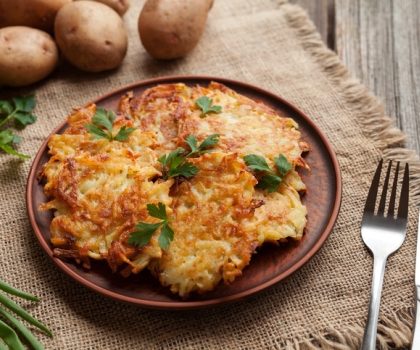Latkes for Chanukah

By Nina Polien Light
Shortly after my husband and I moved into our first home, we decided to host a Chanukah party. Excited about our new, albeit modest, digs and eager to assume the role of grownups, we invited a bevy of relatives and just about every high school and college friend still living in town.
The night before the party, my parents arrived to help with the monumental task of preparing latkes, the addictive fried potato pancakes customarily eaten on Chanukah. As my husband and father peeled 20 pounds of russet potatoes, Mom and I placed the spuds and several onions in a large food processor, grated the ingredients, squeezed out the excess moisture and turned the potato-onion mixture into an oversize bowl where it was combined with eggs, flour, salt and ground black pepper.
Frying the latkes was a challenge on the temperamental electric range we acquired with the house. The guys ladled mounds of batter into frying pans filled with sizzling vegetable oil, flattened them into pancakes and kept watch to determine the exact moment to flip the latkes—turn them too soon and the batter would turn to mush, but wait too long and they would scorch.
As crispy latkes emerged from the frying pan, Mom and I blotted them of excess oil with paper towels before arranging them in an aluminum pan. I don’t remember how many latkes we made, but I know I counted them because I expected my grandmother to ask for a tally. She did not disappoint.
It snowed on the day of the party, so we placed towels near the front door to shield the carpet from guests’ wet boots. We positioned a banquet table in the family room to hold platters of latkes, corned beef and rye bread as well as the appetizers, side dishes and desserts our guests were bringing.
As people arrived, it became apparent our home was not a large enough venue: Towels could not contain the boots, and we sighed as melting snow puddled on the carpet. We ran out of space in the tiny coat closet and had to pile parkas on our bed. There was not nearly enough room on the food table to hold the bounty our guests brought, so we scattered their offerings on every surface throughout the house. And we definitely needed more chairs. But there was no shortage of good eats.
The presentation may not have been up to Martha Stewart’s standards, but folks had fun and asked to be on the following year’s guest list. We kept up the tradition until our daughters were born and—as other couples added to their ranks, too—the numbers grew too unwieldy in our humble accommodations.
We discussed reviving the party when we moved to a larger home 17 years ago, but found ourselves making new memories with our children, who enjoyed hearing stories about the miracle of Chanukah. We explained Chanukah is not the “Jewish Christmas,” but a relatively minor festival that often gets equated with Noel because of close proximity on the calendar.
Chanukah, also known as the Festival of Lights, is about miracles and can be traced to the time of the second Holy Temple, when the ruling Syrian-Greeks forbade Jews from practicing their faith. The first miracle occurred when the Maccabees, a small Jewish army, overtook the much larger Syrian-Greek army. The second miracle happened when a one-day supply of the only ritually pure olive oil left in the Holy Temple burned for a remarkable eight days.
To commemorate the miracles, Jews fry foods in oil—latkes in some cultures and sufganyot (doughnuts) in others—and light a menorah (candelabra) for eight nights, starting with one candle the first evening and ending with eight candles the last. Children spin four-sided dreidels (tops), each side emblazoned with the first letter of the words in the Hebrew phrase, nes gadol haya sham (a great miracle happened there).
Sitting in the glow of the menorah provides an ideal setting for reflecting on the miracles in our own lives. Frivolously, I could say it was a miracle my former house withstood the enormity of those long-ago Chanukah parties.
But now that two of my own miracles are away at college and busy with their own pursuits, I look—somewhat wistfully—at the bigger picture. For me, the greatest miracle is when all three girls are home to light the menorah together.
